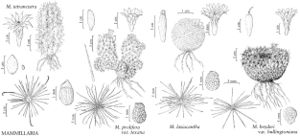Difference between revisions of "Mammillaria tetrancistra"
Amer. J. Sci. Arts, ser. 2, 14: 337. 1852.
FNA>Volume Importer |
imported>Volume Importer |
||
| (2 intermediate revisions by 2 users not shown) | |||
| Line 8: | Line 8: | ||
}} | }} | ||
|common_names=Common fishhook cactus | |common_names=Common fishhook cactus | ||
| + | |special_status={{Treatment/ID/Special_status | ||
| + | |code=F | ||
| + | |label=Illustrated | ||
| + | }} | ||
|basionyms= | |basionyms= | ||
|synonyms= | |synonyms= | ||
| Line 47: | Line 51: | ||
|publication title=Amer. J. Sci. Arts, ser. | |publication title=Amer. J. Sci. Arts, ser. | ||
|publication year=1852 | |publication year=1852 | ||
| − | |special status= | + | |special status=Illustrated |
| − | |source xml=https:// | + | |source xml=https://bitbucket.org/aafc-mbb/fna-data-curation/src/2e0870ddd59836b60bcf96646a41e87ea5a5943a/coarse_grained_fna_xml/V4/V4_459.xml |
|subfamily=Cactaceae subfam. Cactoideae | |subfamily=Cactaceae subfam. Cactoideae | ||
|genus=Mammillaria | |genus=Mammillaria | ||
Latest revision as of 21:58, 5 November 2020
Plants branched; branches 1–several. Roots fleshy taproots, to 24 cm, 5–8 cm diam. Stems cylindric to ovoid-cylindric, commonly 5–15(–25) × 3.5–7(–10) cm, flaccid; tubercles 4 mm diam.; axils short woolly; cortex and pith mucilaginous; latex absent. Spines 21–64 per areole, dark or light colored, depending largely on substrate color, glabrous (to hoary); radial spines 30–46(–60) per areole, white, bristlelike, 6–10 × 0.09–0.15 mm, stiff; central spines 1–3(–4) per areole, porrect or strongly projecting, usually hooked, (6–)13–18(–25) × (0.2–)0.3(–0.4) mm; subcentral spines several, often 12+ per areole, radiating in all directions, often resembling supplementary ring of radial spines, barely distinguishable from radial spines, stouter, longer and dark tipped or purplish. Flowers 2.5 × 2.5–3.5 cm; outermost tepal margins long fringed; inner tepals pink to rose-purple, margins sometimes paler or white, at least proximally, 24–26 × 4 mm; stigma lobes yellow-green to green. Fruits bright red, ellipsoid or cylindric to clavate, (8–)15–30 × 5–10 mm, juicy only in fruit walls; floral remnant quickly deciduous, leaving conspicuous abscission scar. Seeds black, conspicuously strophiolate, 1.4–2.4 × 1.4 mm, pitted and rugose; testa hard; anticlinal cell walls straight (not undulate); interstices narrower than pit diameters; pits bowl-shaped; strophiole tan, large, corky. 2n = 22.
Phenology: Flowering Apr, Jul; fruiting Feb–Apr, Sep–Oct.
Habitat: Mojave and Sonoran Deserts, alluvium and outcrops, valley floors, hills, mountainsides
Elevation: 100-1500 m
Distribution

Ariz., Calif., Nev., Utah, Mexico (Baja California, Sonora).
Discussion
Mammillaria tetrancistra extends farther into hyper-arid California deserts than any other species of Mammillaria.
Without the unique seeds, its identification requires detailed comparison with both Mammillaria grahamii and M. viridiflora. Although M. viridiflora is ecogeographically segregated (more mesophytic), the other taxa grow intermingled at many sites in southwestern Arizona. Pushing the side of the stems with a stick or stone allows crude field identification for two commonly confused species: stems of M. tetrancistra are soft and flabby, whereas stems of M. grahamii are firm.
Selected References
None.
